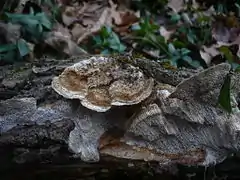Coriolopsis gallica
Coriolopsis gallica is a fungus found growing on decaying wood. It has not been associated to any plant disease, therefore it is not considered pathogenic. For various Coriolopsis gallica strains isolated, it has been found, as a common feature of the division Basidiomycota, that they are able to degrade wood components, mainly lignin and to lesser extent cellulose, which results in a degradation area covered by the accumulating -white- cellulose powder, therefore, C. gallica might be generically called, as many other Basidiomycetes, as "white-rot" fungi.[1]
| Coriolopsis gallica | |
|---|---|
 | |
| Scientific classification | |
| Kingdom: | |
| Division: | |
| Class: | |
| Order: | |
| Family: | |
| Genus: | |
| Species: | C. gallica |
| Binomial name | |
| Coriolopsis gallica | |
| Synonyms | |
| |
This feature of preferential degradation of lignin components, such as melanoidins, polyphenols, and other aromatic compounds is of biotechnological interest in the industries of paper (recycling and bleaching), beer and sugar cane production or for the bioremediation of waste waters produced in these and other industrial activities. While in Basidiomycota, the lignolytic activities are jointly played by enzymes such as laccases, manganese peroxidases and lignin peroxidases, in Coriolopsis gallica, as well as in the phylogenetically related Trametes spp., laccases (even in multiple genomic copies) are the main mechanisms involved in lignin modification, while in another well studied white-rot basidiomycota Phanerochaete spp., virtually no laccase activity is involved in lignin biodegradation. [2]
References
